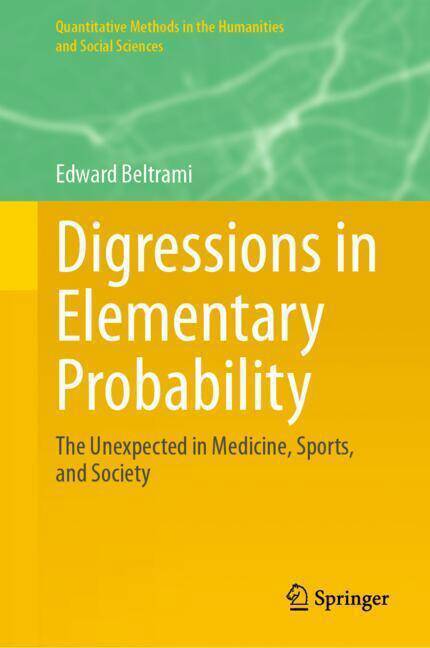
- Retrait gratuit dans votre magasin Club
- 7.000.000 titres dans notre catalogue
- Payer en toute sécurité
- Toujours un magasin près de chez vous
- Retrait gratuit dans votre magasin Club
- 7.000.0000 titres dans notre catalogue
- Payer en toute sécurité
- Toujours un magasin près de chez vous
Digressions in Elementary Probability
The Unexpected in Medicine, Sports, and Society
Edward BeltramiDescription
This book is about the interplay between chance and order, but limited to mostly binary events, such as success/failure as they occur in a diversity of interesting applications. The goal is to entertain and instruct with topics that range from unexpected encounters with chance in everyday experiences, to significant "must know" insights regarding human health and other concerns in the social sciences.
The first section provides the tools for being able to discuss random sequences with hints at what is to follow. This is followed by another surprising and, to some extent, bizarre result known as Stein's Paradox, which is applied to baseball.
The troublesome topic of disease clusters, namely to decide whether the clumping of events is due to chance or some environmental cause, is treated using both the Poisson and normal approximations to the binomial distribution and this leads naturally into a discussion of the base rate fallacy and a case study of hospital performance. Next, another medical case study this time concerning some tricky questions about the effectiveness of colonoscopy and other medical interventions. A brief discussion of the mathematics of clinical trials, follows.
Then, the book examines the error in random sampling, when polling for candidate preference with specific current examples. The essential tool here is covariance of random variables. The author follows this with a treatment of the spooky quality of coincidence using appropriate mathematical tools. After this, code breaking at Bletchley Park using Baye's theorem. It returns to Poisson events to discuss another unexpected result, followed by the use of spatial Poisson events in the delivery of emergency response services.
Finally, an account of fluctuations that occur in a run of Bernoulli trials as a bookend to the very first section of the book. The probability theory involved is elementary using the binomial theorem and its extensions to Poisson and normal events in addition to conditional probability and covariance. The author provides an optional brief tutorial at the end, that covers the basic ideas in probability and statistics needed in the main text. Besides a list of references, several codes written in Matlab that were used to illustrate various topics in the text, as well as to support several figures that appear throughout, are provided.
Spécifications
Parties prenantes
- Auteur(s) :
- Editeur:
Contenu
- Nombre de pages :
- 121
- Langue:
- Anglais
- Collection :
Caractéristiques
- EAN:
- 9783031700507
- Date de parution :
- 25-10-24
- Format:
- Livre relié
- Format numérique:
- Genaaid
- Dimensions :
- 163 mm x 238 mm
- Poids :
- 344 g

Les avis
Nous publions uniquement les avis qui respectent les conditions requises. Consultez nos conditions pour les avis.






